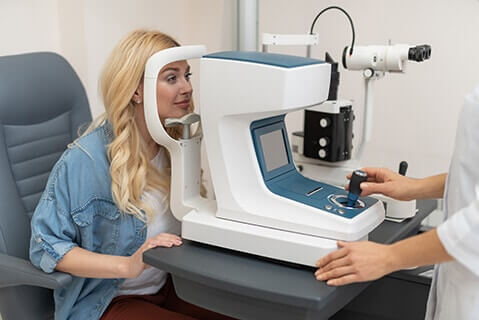Treatment of Diabetic Macular Edema

Diabetic macular edema (DME) is a swelling or thickening of the macula, the small area in the center of the retina, which allows us to see fine details clearly. DME is caused by fluid leaking from small retinal blood vessels damaged by diabetes, and this causes blurred vision. It is the most common cause of visual loss in diabetes. Vision loss can range from mild to severe, but even in the worst cases, peripheral vision continues to function. Laser treatment is often recommended for people with DME.
Laser treatment is performed in your doctor’s office or eye clinic as an outpatient procedure The main goal of treatment is to prevent further loss of vision, but improvement in vision is possible. Conventional laser treatment for DME uses a continuous-wave laser to create numerous small burns in the retina. While conventional laser is an effective treatment, the retinal burns, result in permanent and often progressive retinal scarring, and can cause visual loss.
What is MicroPulse Laser Therapy?
In contrast to conventional laser treatment, MicroPulse laser therapy (MPLT) has been proven effective without producing laser burns. MPLT chops the continuous-wave laser beam into a train of tiny, repetitive, low energy pulses separated by a brief rest period in between. This “micropulsing” allows the retina to cool between laser pulses, preventing burns and retinal damage. With MPLT, risks are reduced or eliminated, with less pain and discomfort than conventional laser treatment; and therefore can be repeated as needed without harm to your vision.
What to Expect During MPLT
Before Treatment
Your doctor will make the diagnosis of DME based on a thorough clinical history and examination, usually involving retinal imaging tests to confirm the diagnoses and to provide additional important information. If MPLT is recommended, an informed consent form will be given to you for your review and signature, and all of your questions regarding treatment will be answered.
During Treatment
To perform MPLT, your eye must be dilated. The lights in the office will be dimmed and you will be seated facing the laser machine with your doctor facing you. A special viewing lens will be placed on the front of your eye to perform MPLT. A drop of a topical anesthetic makes this comfortable. Your doctor will place several laser applications in the areas of DME. Treatment usually takes minutes, and is painless. Based on the laser wavelength used, you may experience some flashing lights during the procedure. If you move during treatment there will be no harm to your eye, but it may lengthen the treatment time. At the end of MPLT, the special viewing lens on your eye will be removed.
After Treatment
For the rest of the day, your vision may be a little blurry. Due to the lens placed on your eye during treatment, it is common to experience a little irritation on the front of your eye for a few hours after treatment. This irritation is usually mild and is lessened by use of frequent artificial tear-drops. Significant pain after treatment should not occur. If it does, contact your doctor. By the next day, your vision should be as it was before treatment. Vision improvement typically occurs after months; however, patients may notice better vision within days to weeks after treatment.
Following MPLT, it is important for you to continue to follow-up with your doctor on a regular basis for continued monitoring of your condition. How soon and how often follow-up examination is required will be determined by your doctor.

